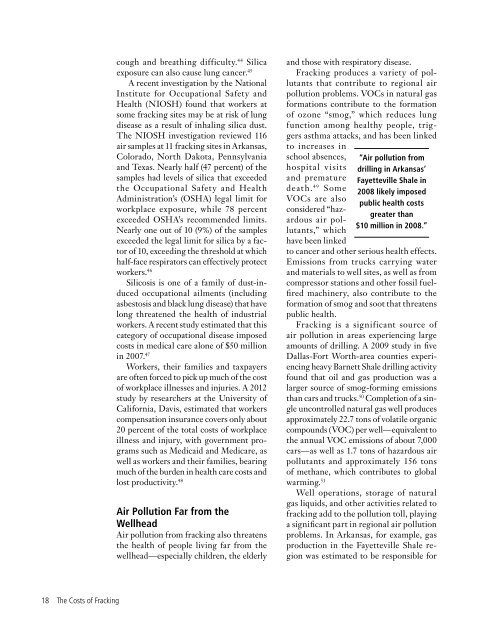The Costs of Fracking
The Costs of Fracking vMN.pdf - Environment Minnesota
The Costs of Fracking vMN.pdf - Environment Minnesota
Create successful ePaper yourself
Turn your PDF publications into a flip-book with our unique Google optimized e-Paper software.
cough and breathing difficulty. 44 Silica<br />
exposure can also cause lung cancer. 45<br />
A recent investigation by the National<br />
Institute for Occupational Safety and<br />
Health (NIOSH) found that workers at<br />
some fracking sites may be at risk <strong>of</strong> lung<br />
disease as a result <strong>of</strong> inhaling silica dust.<br />
<strong>The</strong> NIOSH investigation reviewed 116<br />
air samples at 11 fracking sites in Arkansas,<br />
Colorado, North Dakota, Pennsylvania<br />
and Texas. Nearly half (47 percent) <strong>of</strong> the<br />
samples had levels <strong>of</strong> silica that exceeded<br />
the Occupational Safety and Health<br />
Administration’s (OSHA) legal limit for<br />
workplace exposure, while 78 percent<br />
exceeded OSHA’s recommended limits.<br />
Nearly one out <strong>of</strong> 10 (9%) <strong>of</strong> the samples<br />
exceeded the legal limit for silica by a factor<br />
<strong>of</strong> 10, exceeding the threshold at which<br />
half-face respirators can effectively protect<br />
workers. 46<br />
Silicosis is one <strong>of</strong> a family <strong>of</strong> dust-induced<br />
occupational ailments (including<br />
asbestosis and black lung disease) that have<br />
long threatened the health <strong>of</strong> industrial<br />
workers. A recent study estimated that this<br />
category <strong>of</strong> occupational disease imposed<br />
costs in medical care alone <strong>of</strong> $50 million<br />
in 2007. 47<br />
Workers, their families and taxpayers<br />
are <strong>of</strong>ten forced to pick up much <strong>of</strong> the cost<br />
<strong>of</strong> workplace illnesses and injuries. A 2012<br />
study by researchers at the University <strong>of</strong><br />
California, Davis, estimated that workers<br />
compensation insurance covers only about<br />
20 percent <strong>of</strong> the total costs <strong>of</strong> workplace<br />
illness and injury, with government programs<br />
such as Medicaid and Medicare, as<br />
well as workers and their families, bearing<br />
much <strong>of</strong> the burden in health care costs and<br />
lost productivity. 48<br />
Air Pollution Far from the<br />
Wellhead<br />
Air pollution from fracking also threatens<br />
the health <strong>of</strong> people living far from the<br />
wellhead—especially children, the elderly<br />
and those with respiratory disease.<br />
<strong>Fracking</strong> produces a variety <strong>of</strong> pollutants<br />
that contribute to regional air<br />
pollution problems. VOCs in natural gas<br />
formations contribute to the formation<br />
<strong>of</strong> ozone “smog,” which reduces lung<br />
function among healthy people, triggers<br />
asthma attacks, and has been linked<br />
to increases in<br />
school absences,<br />
hospital visits<br />
and premature<br />
deat h. 49 Some<br />
VOCs are also<br />
considered “hazardous<br />
air pollutants,”<br />
which<br />
have been linked<br />
“Air pollution from<br />
drilling in Arkansas’<br />
Fayetteville Shale in<br />
2008 likely imposed<br />
public health costs<br />
greater than<br />
$10 million in 2008.”<br />
to cancer and other serious health effects.<br />
Emissions from trucks carrying water<br />
and materials to well sites, as well as from<br />
compressor stations and other fossil fuelfired<br />
machinery, also contribute to the<br />
formation <strong>of</strong> smog and soot that threatens<br />
public health.<br />
<strong>Fracking</strong> is a significant source <strong>of</strong><br />
air pollution in areas experiencing large<br />
amounts <strong>of</strong> drilling. A 2009 study in five<br />
Dallas-Fort Worth-area counties experiencing<br />
heavy Barnett Shale drilling activity<br />
found that oil and gas production was a<br />
larger source <strong>of</strong> smog-forming emissions<br />
than cars and trucks. 50 Completion <strong>of</strong> a single<br />
uncontrolled natural gas well produces<br />
approximately 22.7 tons <strong>of</strong> volatile organic<br />
compounds (VOC) per well—equivalent to<br />
the annual VOC emissions <strong>of</strong> about 7,000<br />
cars—as well as 1.7 tons <strong>of</strong> hazardous air<br />
pollutants and approximately 156 tons<br />
<strong>of</strong> methane, which contributes to global<br />
warming. 51<br />
Well operations, storage <strong>of</strong> natural<br />
gas liquids, and other activities related to<br />
fracking add to the pollution toll, playing<br />
a significant part in regional air pollution<br />
problems. In Arkansas, for example, gas<br />
production in the Fayetteville Shale region<br />
was estimated to be responsible for<br />
18 <strong>The</strong> <strong>Costs</strong> <strong>of</strong> <strong>Fracking</strong>



